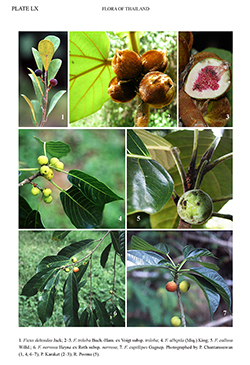e-Flora of Thailand
Volume 10 > Part 4 > Year 2011 > Page 533 > Moraceae > Ficus
PHA2. Ficus callosa Willd.wfo-0000687654
Act. Acad. Berol.: 102, t. 4. 1798; Miq., Ann. Mus. Bot. Lugd. Bat. 3: 295. 1867; Kurz, Forest Fl. Burma 2: 454. 1877; King, Ann. Roy. Bot. Gard. (Calcutta) 1(1): 64, t. 85. 1887; Gagnep., Fl. Indo-Chine 5: 773. 1928; Kochummen, Tree Fl. Malaya 3: 142, f.7. 1978; C.C.Berg & Corner, Fl. Males., Ser. 1, Spermat. 17(2): 166. 2005. Plate LX: 5.
Accepted Name : This is currently accepted.
Synonyms & Citations :
Description : Tree to 20(–)45 m tall, with buttresses, deciduous. Branchlets drying dark brown; stipule scars prominent. Leafy twigs 3–8 mm thick, solid, sparsely minutely puberulous to glabrous. Leaves spirally arranged; lamina elliptic, oblong or subobovate, (8–)10–30(–45) by (4–)5–15(–25) cm, (almost) symmetrical, coriaceous, apex shortly and bluntly acuminate to rounded, base equilateral to slightly inequilateral, broadly to narrowly subcordate, rounded or subattenuate, margin entire (lobate and/or (towards the base) dentate when juvenile), ± revolute; upper surface glabrous, shining when dry, lower surface glabrous, scabridulous; cystoliths only below; midrib slightly prominent to flush above, lateral veins (6–)9–12 pairs, the basal lateral veins to ca ⅒–⅙ the length of the lamina, faintly or not branched, most other lateral veins branched or forked away from the margin, tertiary venation (±loosely) scalariform, the smaller veins (almost) flush beneath; waxy glands absent; petiole 3–7(–9) cm long, (often) varying in length on the same twig, glabrous, lenticellate, the epidermis persistent; stipules 1–3(–5) cm long, white (sub)sericeous, caducous. Figs axillary, solitary (or in pairs); peduncle 0.2–2 cm long; basal bracts 3, 1.5–4 mm long, persistent; receptacle subglobose, ovoid or ellipsoid, 1.5–2.5 cm diam. when dry, 0.1–1 cm long stipitate, minutely white puberulous, green (or yellow?) at maturity, apex slightly umbonate, ostiole ca 1–1.5 mm diam., prominent; internal hairs absent. Tepals reddish, glabrous. Stamens (1–)2.
Thailand : NORTHERN: Chiang Mai; NORTH-EASTERN: Loei; EASTERN: Nakhon Ratchasima; SOUTH-WESTERN: Kanchanaburi, Prachuap Khiri Khan; CENTRAL: Saraburi; SOUTH EASTERN: Chon Buri; PENINSULAR: Nakhon Si Thammarat, Trang, Songkhla, Yala, Narathiwat.
Distribution : Sri Lanka, India (type, NE, Andaman and Nicobar Islands), Bangladesh, Burma, Laos, Vietnam, Cambodia, Peninsular and Bornean Malaysia, Indonesia (Sumatra, Java, Kalimantan, Sulawesi, Lesser Sunda Islands, Moluccas), the Philippines.
Ecology : Evergreen, dry evergreen and mixed deciduous forests, near streams, to 1,050 m alt.
Vernacular : Ka pung (กะปุง), lin khwai (ลิ้นควาย), ma duea kwang (มะเดื่อกวาง)(Central); khong (ฆ้อง)(Saraburi); tong nang (ตองหนัง)(Loei); lin krabue (ลิ้นกระบือ)(Uttaradit); ma duea ton (มะเดื่อต้น)(Chanthaburi).
Notes: In the juvenile state the lamina can be oblong to lanceolate and ± lobate (and to 60 by 23 cm, with to 22 pairs of lateral veins) or elliptic and entire. In both types of lamina the margin is spinulose-dentate towards the base. The two types of lamina can be found side by side on treelets, being apparently descendants of the same tree. In the juvenile state the lamina has waxy glands in the axils of the basal lateral veins and also (less clearly) at the base of the midrib above. Such glands are not present in the adult state.

